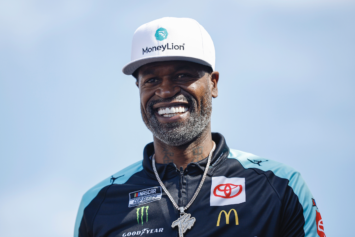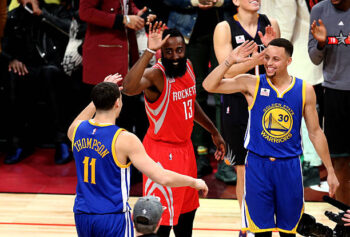Andrew Bynum’s debut album would have to be called Enigmatic.
Despite growing up in New Jersey and playing high school ball smack dab in the middle of the New York-Philadelphia corridor, Bynum was relatively under–hyped when he popped onto the NBA scene, not even invited to the 2005 NBA Draft. He and his camp had to buy tickets and sit in the stands like fans. Since then, Bynum has had a career of highs and lows – like an episode of TV One’s Unsung. Yeah, he’s a two-time champion and All-Star center, generally viewed as the second-best big man in the game behind Dwight Howard; but, as we know, his career has also been one of injury-plagued absences, flagrant foul suspensions and bouts of pouting that would not garner “M” ratings for maturity.
So, he’s risen out of nowhere, spent seven seasons in Los Angeles and then, in the offseason, been traded to Philadelphia (near his old stomping grounds) where he’s expected to be the focal point of a young upstart contender. What’s this dude’s story, though?
“Janet had a vision for her son,” said, a close family friend, Ed Lloyd, whose son Jonathan played travel basketball with Bynum starting in the fifth grade in Plainsboro, New Jersey. “She was ambitious and she deserves a whole of credit for nurturing Andrew.”
That ambition focused on providing the best education and environment for success for Andrew. His basketball career just became a part of the equation. College educated, she set roots in central New Jersey near Princeton, in one of the most highly regarded public school districts (West-Windsor Plainsboro) in the state. The plan necessitated living in an apartment complex surrounded by homes worth high-six and often seven figures.
Andrews’ father, Ernest Bynum, and Janet divorced when Andrew was one-year-old. That left Janet raising Andrew and his older brother, Corey, in Plainsboro with the boys occasionally spending time during the summer with Ernest in North Carolina. Living in different area codes wouldn’t interfere with the father’s genetic coding, though. Janet, no small woman herself, stands close to six-feet. But Ernest stood 6-11 and played ball at Long Island University where he still ranks fourth in total blocks for the Blackbirds.
The father always sensed his progeny would grow as tall and would share basketball tips and pointers, especially on the art of shot blocking during their time together in the Tar Heel state. However, the estranged relationship between the parents likely impacted Andrew.
“Every young man needs that internal father voice,” said Lloyd. “Andrew is a good kid, but all the acting tough stuff [the flagrant foul on JJ Barea], I think, is the result of him trying to fit in. Clearly, even if you have a strong figure, it doesn’t always prevent things like that from happening but often that little voice in your head stops a lot of that.”
The uber macho culture of the NBA almost demands dissent. Kobe Bryant gave Bynum an imaginary pat on the head by cosigning his rebellious ill-advised three-point shot last season against the Golden State Warriors. Every player must figure out how they will navigate the need for self-expression and stupid ish.
Bynum’s basketball career began as a gangly fifth grader where he was the tallest but one of the most uncoordinated. By the eighth-grade, he had started to grow into his own body. It was then that Andrew knew he was onto something. The next year, he entered West Windsor-Plainsboro High School North. Joining him at the high school was Jeff Torralba, another AAU teammate.
“I give him a lot of credit for the way he handled himself, though,” said Torralba. “On our AAU and school team, he was the biggest and best kid on the team. He was a good player who could hit the open shot and throw great outlet passes. But, still everybody would ask him, ‘Why aren’t you dominating?’ But, he would block out the negativity and continue to play.”
“If they only knew how far Andrew had come in those few short years,” said Lloyd. “I saw the development. Yes, he always had soft hands, but it was just taking time for him to catch up to his body. And, he was always playing against kids that were older. His birthday is late in the year (October 27) and he should have started school a year later. At that age, that makes a lot of difference.”
But Bynum played through the exaggerated expectations.
“He knew he had the height and the skills,” said Lloyd. “It was just a matter of time for it to fully blossom under the right circumstances.”
Although local legend has it that Bynum was cut from the North team, the truth is that he along with Torralba, played freshmen ball while also being allowed to suit up for JV.
“But after two games, he was gone,” said Torralba. “He left the school over the Christmas holidays and never came back.”
The issue with basketball was just a symptom of the overall concerns that the school and Andrew were not a good fit.
“Janet didn’t have faith in the school to cultivate Andrew,” said Lloyd.
The school was just a few years old and the sports programs suffered during this infancy period.
“The entire district philosophy would not have been best for Andrew’s needs,” said Lloyd. “It didn’t really care about scheduling top flight competition. Janet was a dedicated, single-mom who always talked about providing the best education for her sons. She could have got that at North for Andrew but, by this time, she also began to realize that basketball could be essential to his overall development.”
And Andrew, sensing his own basketball destiny, was up for the challenge of a new school.
“I think that Andrew got really excited about playing varsity as a freshman,” said Torralba of the school that Bynum would next attend.
The Solebury School is a small private school in New Hope, Pennsylvania, a northern suburb of Philadelphia, located about thirty miles from Plainsboro. A graduating class of 50 would be considered large, but the basketball teams – led by coach Cleve Christie and fueled with many inner-city kids looking for a place to blossom – play on par with all the premium programs in the New Jersey-Philadelphia region.
One issue, though: Bynum would have to board at the school. So, just after recently celebrating his 14th birthday, Bynum was alone in the woody environs of East Coast prep school life. Many of the urban kids playing basketball at a school like Solebury do so to avoid the hazards of urban education. Bynum, however, was a suburban kid leaving a school with a highly acclaimed academic reputation.
“I was impressed and respected that,” said Christie. “I mean, the greatest sacrifice a mother can make is to send off her youngest son. And she did her research. I think she knew about our success with big kids. We previously had Dikembe Mutombo’s brother, Shatangi, play for us and at the time we had two upperclassmen that stood 6-7 and 6-8.”
However, it still wasn’t all love for the big kid.
“Andrew was very, very young,” recalls Christie. “He was a good kid and I knew he could play, but I already had a junior and a senior both taller and stronger than Andrew playing in the post. I would have had to play him at the three.”
The family would, however, respond with providing Bynum more protection. Despite being miles away, they all made their presence felt in one way or another. While Bynum’s mother was working and unable to make some games, Bynum’s older brother Corey was always there as a shadow.
“His brother, Corey, would come to all the games up and practice with us,” said Christie. “He was about 6-4 and could play, but he realized that the little brother had the potential. He would push Andrew in practice all the time. Only then, would Andrew begin to push back – not only with Corey, but against his teammates, too.”
“But one time, I was running a drill on how to take a charge and Andrew ended up getting hurt,” said Christie. “Soon after that, his mother told me that he didn’t need to learn how to take a charge.”
Christie talked about the two types of kids he usually coached: “One is the tough kid who got knocked around all his life and the other full of love and advice. The tough kid may work a little harder but you never know what kind of bad things they are likely to get into while the other kid may lack that fight they may need at times. I never had to worry about Andrew getting into trouble. He would more likely be in his room playing video games or just wanting an ice cream cone.”
Christie saw Bynum as a “Big East center” and wanted to him prepared. Although Christie never met Andrew’s father, he did occasionally talk to him on the phone. Christie recalls the elder Bynum telling him, “Be patient with my son.”
Bynum finished up his freshman season strong and began to draw some attention as a sophomore but still was not starting. After two years at Solebury, Bynum’s mother decided it was best for Andrew to leave for St. Joseph’s, in Metuchen, NJ, an all-boy parochial school, which had graduated Jay Williams, the Duke All-American and former first-round NBA selection.
Christie, however, believes that the decision had more to do with than just playing time.
“I wanted to become a Nike school and they seemed interested in sponsoring us,” said Christie. “But our gym is kind of antiquated and around here it’s called ‘The Barn.’ It seems they didn’t want to be with us because of our facilities. But they [St. Joseph’s] ended up becoming a Nike school. However, it went down, it worked out for the best for Andrew and I am more than happy for him.”
Again – Janet Bynum had a vision.
Matched up against heralded North Jersey parochial teams such as St. Anthony, St. Patrick’s and St. Benedict’s, Bynum began to receive more attention. But due to injury he only played 16 games in both his junior and senior season. Despite that, the natural maturation of his game led to somewhat gaudy senior averages of 22.4 points, 16.8 rebounds and 5.3 blocks per game and earned him a scholarship offer from the University of Connecticut.
The added exposure helped him get invites to the McDonald’s All-American Game and Jordan Classic. Bynum didn’t wow anyone with statistics, scoring nine points while grabbing five rebounds in the McDonald’s game, but he received rave reviews for the Jordan game held in nearby Madison Square Garden.
His skill set also began to draw the eye of many NBA talent evaluators. Conditioning and weight loss seen at pre-draft workouts impressed the Lakers. In need of a big man to fill the void of the recently departed Shaquille O’Neal, they made a commitment to Bynum to take him at the tenth spot. Very interested in that scenario, Bynum and his camp decided to shut down workouts for other teams.
“Before Andrew declared he was turning pro, I just happened to be at the Newark Airport making a business trip to Boston and ran into him,” said Lloyd. “He told me he was off to LA to snag a deal. Now, seven years later with all that he’s cultivated in LA – the good and the bad – he’s back close to home. I think, if healthy, he will be phenomenal.”
As Bynum approaches his 25th birthday, the City of Brotherly Love has already welcomed him home like a long lost sibling. But that’s only because it’s October. His grace period will be slight, and his penchant for loafing will put a target on his back with the quickness. If he thinks he’s gonna slide by with occasional bursts of energy in Philly (like he did in L.A.), he’ll quickly be recast as a loser. He better be ready.



